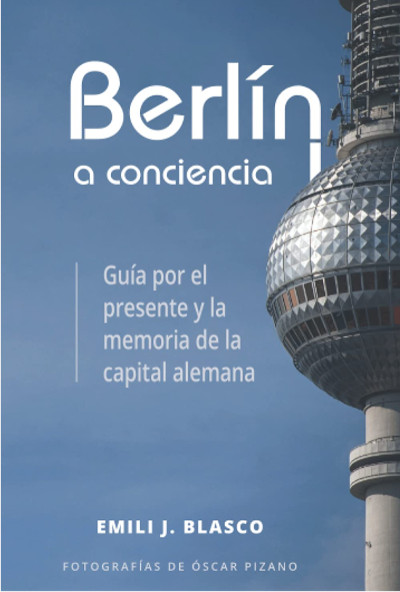In the picture
Cover of the book 'Berlin a conciencia. guide por el presente y la report de la capital alemana', by Emili J. Blasco (Amazon, 2022), 460 pages.
We reproduce the presentation with which the first pages of 'Berlin in Conscience'begin.
At the turn of the century I arrived in Berlin as a press correspondent. It had been my dream. I remember that every time I crossed Unter den Linden, going down Friedrichstrasse, up Wilhelmstrasse or down any other street, I always looked sideways to see the Brandenburg Gate at the end of the promenade. "You're in Berlin," I would repeat to myself at the time. I never got used to it. It was impossible to do so. It was not only the excitement of living in the city I had longed for, but the city itself was in turmoil: everything was new for the Berliners themselves. This was the special moment of the take-off of Berlin's regained capital, once again the seat of parliament and government, and of the simultaneous execution of so many works that were transforming its physiognomy. In time I would move on to other destinations, but my attraction to Berlin would remain as strong as ever.
This book is the result of that fascination. I began writing it with the experience of those years spent in the German capital and have completed it on the basis of subsequent visits. Each trip was an opportunity to see at first hand the growing vitality of this metropolis at the very centre of Europe. On one of the last inspections, I was certain that I had found what I had been waiting for. "Berlin is already Berlin," I exclaimed when I arrived at the new Berlin Hauptbahnhof and saw it bustling with activity. The Central Station stands on a site that before reunification had been a dead zone next to the Wall. Having seen this and other desolate scenes, it was hard to believe that the urban grafts would be able to absorb the old sap and thus restore the body to full functionality. The consolidation of this railway junction as a real Hbf - the nerve centre of activity in German cities, a concept in the national culture - is perhaps the best catalyst for the triumph of the new Berlin.
I approached this project with an eye to the present, but continually looking back to the past as well. More than the narrative spirit of the travelogue notebook , they are driven by a spirit of enquiry. Because of Berlin's extraordinary history, every step through the city has to be taken with a sixth sense, using a fourth dimension: it is the loop which, in front of the image we see, reservation also takes us back to the past frames of that place. The book therefore adopts the formality of a guidebook, because by successively presenting each element of the city, following a pathway with stops, it is easier to move from today to yesterday, from the present to the report of each corner. But this is more of a historical guide than a tourist guidebook: there are no lists of accommodation and addresses for entertainment, and there is a lot of reminiscing about past events. This is useful for those who arrive in Berlin on their first weekend, eager to accompany their walks with a leisurely read. bequest It is also for those who have been there before and want to revisit the city in depth, with the particular perspective I propose and in the light of the literary passages about Berlin by its best chroniclers, from Heinrich Heine to Walter Benjamin, so present in this text.
In all of this there is no hint of melancholy that tries to tinge the colouring of the city of now, the one that looks to the future, with sepia. It actually brightens it up. Arriving at the Berlin Hauptbahnhof today, we must marvel at the grandiose architecture of its roof and the advanced engineering of its deep underground, but having seen glimpses of its past, we can marvel even more at the city's ambitions and possibilities. The seduction of what the capital is - and what it can be - from what it was: that is the perspective from which these pages are written.
The chapters of the book are divided into two parts of similar length. On the one hand, what I have called inner Berlin, i.e. the historical core of the city, which basically corresponds to the Mitte district. On the other hand, Berlin Outside the Walls, which includes areas that the early urban growth also left in the centre, as well as other more distant areas in the east and west of the city. The management assistant division of Berlin establishes twelve districts(Bezirke), which in turn are subdivided into 96 neighbourhoods(Ortsteile); the names and boundaries of the latter are used here as reference letter. Each chapter is accompanied by a map, on which the places are marked in an argumentative order, not necessarily following a pathway; the scales of the maps vary according to the space covered.
The photographs are by Óscar Pizano, a photojournalist, cameraman and editor, based in Berlin for many years, residency program , who has worked for various media, including CNN, Deutsche Welle and TVE. Daniela Santamariña, graphics editor at National Geographic, has taken care of the cartography, design and other editing details.

